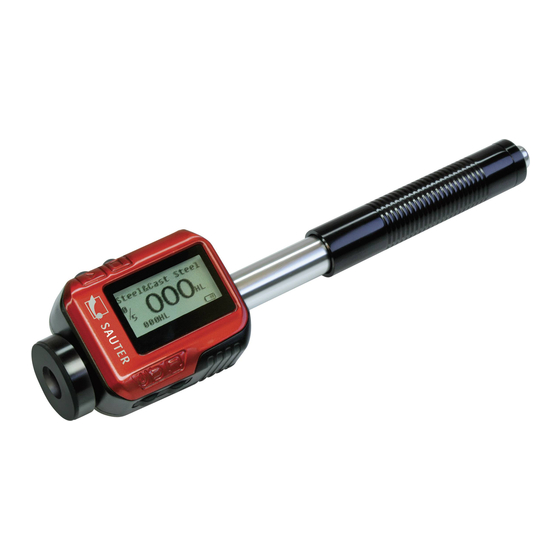Table of Contents
Advertisement
Quick Links
MOBILE LEEB HARDNESS TESTER
Table of contents
Cautions
1.
Summary
1.1
Measuring Principle Scope
1.2
Hardness Value „L"
1.3
1.4
1.5
2.
3.
4.
5.
5.1
5.2
LCD Screeen
5.3
Settings
5.3.1
5.3.2
5.3.3
5.3.4
How to browse Data
5.3.5
5.3.6
Calibration
5.4
5.5
5.6
5.7
6.
7.
7.1
7.2
8.
9.
9.1
9.2
9.3
Applicable Standards
10.
Cautions
Please carefully read this first
1. Any components of the instrument may not be
submerged into water or exposed to rain, which could
HN-D-BA-e-1213
Sauter GmbH
Ziegelei 1
D-72336 Balingen
E-Mail: info@sauter.eu
Instruction Manual
HN-D
cause a battery explosion ort he display might be
damaged.
2. If the instrument isn't used for a longer period, it should
be stored in dry environment and in its original transport
case. The environmental temperature should be within the
range of -30°C up to +80°C and relative humidity from
(RH) 5% bis 95%.
1.
1.1
When the test is carried out, an impact body with a
tungsten carbide test tip is being impelled by spring force
against the surface to be tested, from which it rebounds.
Impact and rebound velocities are measured by the
following method: a permanent magnet integrated in the
impact body passes through a coil and induces an electric
voltage during its travel back and forth. These voltages are
proportional to the velocities and are processed and
displayed as the hardness value "L" at the instrument.
Modern electronics with power saving features provide a
long operating life.
Illustration
The big-sized LCD display always shows how the HN-D is
configured to test.
Variable function keys allow quick changes of common test
parameters. No subjective measuring errors are possible,
giving highly repeatable results. Internal self diagnostics
with error messages assure reliable test results.
Readings can be stored automatically in the internal
memory or being directly sent to a printer. PC evaluation
software enables a data analysis. These conversions to
other scales (HRC, HRB, HB, HV, HSD etc.) are
programmed into the electronics and can be shown directly
on the display as test result.
1.2 Hardness Value „L"
This term, 1978 introduced by Dr. Dietmar Leeb into
measuring technology, is the quotient fort he impact body's
rebound and impact velocity, multiplied by 1000. Harder
materials produce higher rebound velocities than less
harder ones. With reference to a particular material group
Tel: +49-[0]7433- 9933-199
Fax: +49-[0]7433-9933-149
Internet: www.kern-sohn.com
Summary
Measuring Principle Scope
1
Advertisement
Table of Contents

Summary of Contents for sauter HN-D
-
Page 1: Table Of Contents
The Format of Memory Data Backlight Automatic Shut-Off Charging Data Printing The big-sized LCD display always shows how the HN-D is Hardness Testing configured to test. Checking of Settings Variable function keys allow quick changes of common test Sample Preparation parameters. -
Page 2: Features
Other accessories, not included in delivery, can be disponible at 1.4 Applications any time by SAUTER GmbH. All items should be only used with the original , authorized instruments. The use of these - Convenient for all materials accessories with other instruments could cause problems - Best suited for on-site testing of heavy, big or already and any repair costs would not be covered by warranty. -
Page 3: Material Type
Sauter GmbH Ziegelei 1 Tel: +49-[0]7433- 9933-199 D-72336 Balingen Fax: +49-[0]7433-9933-149 E-Mail: info@sauter.eu Internet: www.kern-sohn.com Instruction Manual HN-D Illustration: highlighted Hardness Scale character Menu & Select“ “Print“ „ON / OFF & Back“ : „Hardness Calibration“: press and hold then press for 2 seconds to display the calibration mode. -
Page 4: Setting Date And Time
, it can be increased from 0 to 9 to set the “hundred” bit. 5.3.5 Setting Date and Time The HN-D has gota built-in real-time-clock. Clock and 5. By pressing the button , the „ten“ bit will be calendar have to be adjusted if it is necessary. The highlighted. -
Page 5: Automatic Shut-Off
Batteries have to be recharged when they are used for the first time or an exhaustion of electricity arises. First the HN-D has to be connected with the charger by using the USB cable, then the charger has to be connected with the AC socket to start charging. -
Page 6: Troubles And Solutions
The large LCD display always contact our company, send your instrument to our address. shows how HN-D Impact Hardness Tester is configured to We will care for a prompt checking and if necessary, repair the tests. Variable function screen allows a quick change of the device. -
Page 7: Appendix 3 Measuring Range
Sauter GmbH Ziegelei 1 Tel: +49-[0]7433- 9933-199 D-72336 Balingen Fax: +49-[0]7433-9933-149 E-Mail: info@sauter.eu Internet: www.kern-sohn.com Instruction Manual HN-D 10. Declaration of Conformity 2) The shape of the sample surface Leeb testing principle demands that the velocity of rebound and impact are on the same line, because the impact body is moving in a metal tube.

















Need help?
Do you have a question about the HN-D and is the answer not in the manual?
Questions and answers